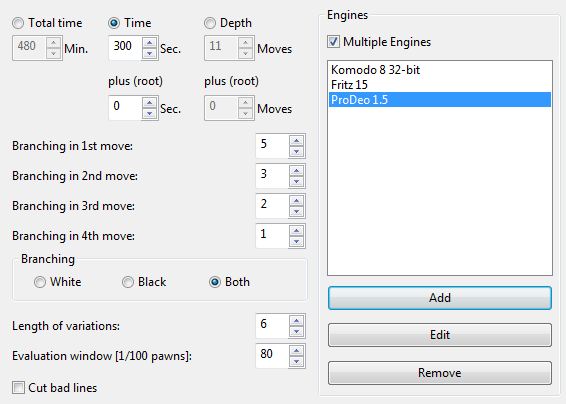|
Deep position analysis |

|

|
|
|
Deep position analysis |

|

|
Deep position analysis
Analysis – Deep position analysis
This function is used to analyse a specific position. It is very good for getting deep and detailed analysis of a critical position, and especially interesting for correspondence players.
Deep position analysis generates a detailed analysis tree for this position. You can determine how deep and broad the tree should be and what moves should be included or excluded from the analysis.

Time/depth: The precision of the analysis is determined by time available per move, or by the fixed calculation depth you allocate. Time per move is more flexible since it allows the program to go much deeper in certain positions (e.g., in the endgame). If on the other hand you are doing the analysis in the background then fixed depth is better since the analysis will be fully executed even if the program is only getting very little CPU resources.
Plus (root) allows you to add extra time or search depth to the root position, so that it is analysed more deeply than positions that occur in the search.
Branching: The branching factors for the 1st, 2nd and 3rd moves define how many alternative moves are given. The higher the values, the broader the analysis tree. However, the program may change the branching factor if it thinks the position merits that. This is dependent on the evaluation window described below. If there are moves present after the position, these will always be considered.
Branching: White, Black, both determines whether alternatives should be given for one or both sides. Example: you want to show that in a certain position White is winning by force. Then you are not too interested in white alternatives and should set branching for Black only.
Length of variations: Sets the length of analysed variations.
Evaluation window: This value, given in 100ths of a pawn, determines when a variation will be discarded. The value 80, for instance, means that moves which are 0.8 pawns worse than the best move will not be investigated any further, even if the branching factor would allow it.
The Threshold determines when a move is considered a mistake. This is described in "centipawns” (one hundredth of a pawn’s value).
At the end of deep position analysis, all the variations that have been generated are sorted and the strongest moves becomes the main line.

Cut bad Lines means that bad continuations, as recognized by the Alpha-Beta algorithm, are ignored and not examined any deeper.
Note
![]() You can influence the analysis by entering continuations to the game. These moves and variations will always be taken into consideration. If you do not enter any moves then the program is free to look at any lines it thinks are worthwhile.
You can influence the analysis by entering continuations to the game. These moves and variations will always be taken into consideration. If you do not enter any moves then the program is free to look at any lines it thinks are worthwhile.
![]() If you annotate a move with a "?" then it will not be taken into consideration. So this is an excellent way to exclude lines you know will lead to nothing, but which the program would otherwise analyse extensively.
If you annotate a move with a "?" then it will not be taken into consideration. So this is an excellent way to exclude lines you know will lead to nothing, but which the program would otherwise analyse extensively.
![]() You can use more than one engine to analyse a position. The engines are used in the order in which they are listed – if you have four engines and two lines then the first two engines will be used for these.
You can use more than one engine to analyse a position. The engines are used in the order in which they are listed – if you have four engines and two lines then the first two engines will be used for these.
![]() It is often better to give let the program analyse many alternatives for one side only. For instance if you want to know if White can force a win in a given position you may set a branching factor only for Black to see if the program can find any defence against the best white attack.
It is often better to give let the program analyse many alternatives for one side only. For instance if you want to know if White can force a win in a given position you may set a branching factor only for Black to see if the program can find any defence against the best white attack.